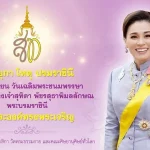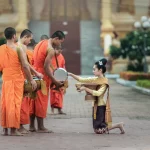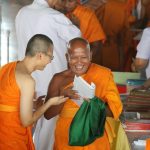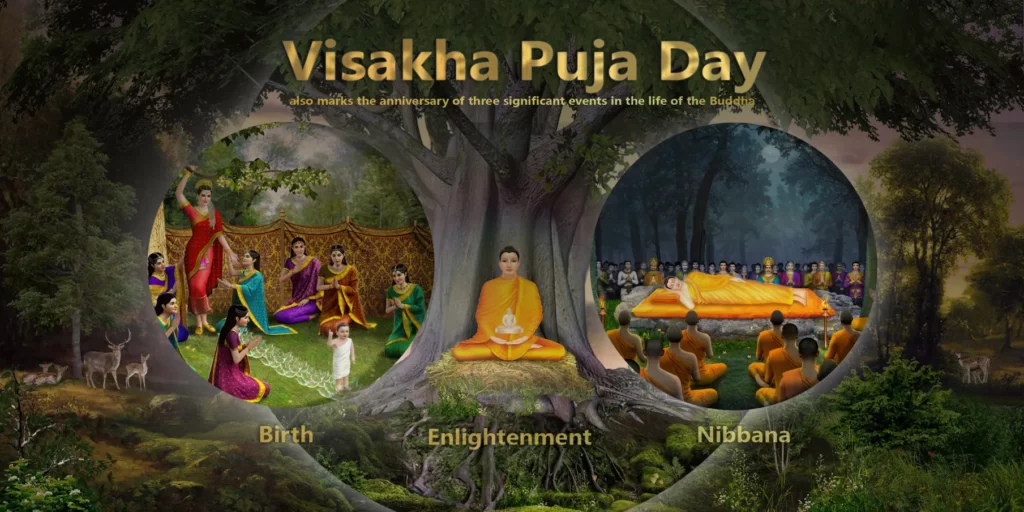
VISAKHA PUJA DAY
Birth - Enlightenment - Nibbana
Visakha Puja Day or Vesak Day is one of the most important days in Buddhism and for all Buddhists. It is the day Buddhists assemble to commemorate the life of the Lord Buddha, and to revere his purity, profound wisdom and immense compassion for all humankind and living beings by reflecting and applying his teachings as guidelines for their lives. Visakha Puja Day also marks the anniversary of three significant events in the life of the Buddha – His Birth, Enlightenment, and Attainment of Complete Nirvana – that occurred on the 15th day of the 6th lunar month.
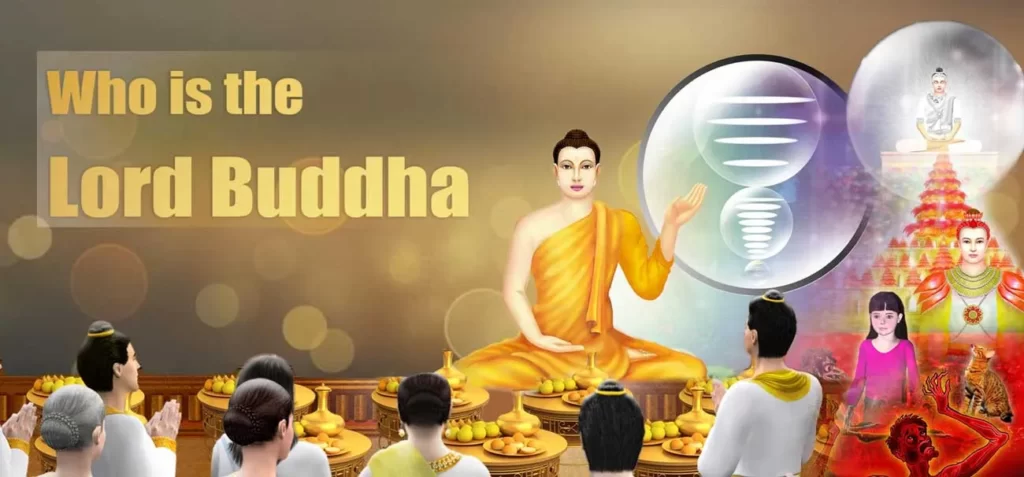
Who is the Lord Buddha?
Siddhattha was the birth name of the Lord Buddha which means “the one whose purpose has been attained.” He was a prince of the king Suddhodana who ruled the kingdom of Kapilavastu of Shakya clan, and his mother was queen Sirimahamaya who was from the Koliyan clan.
As Prince Siddhattha grew older, he detached from material wealth for he felt that it’s not life’s ultimate goal. His heart was moved by a desire to acquire wisdom, the truth about life in a world of sorrow and suffering. Also, he would rather go in search of true and lasting happiness.
All of us see birth, aging, sickness and death as natural occurrences but not so with Prince Siddhattha. He realized that one day he also would be aging, getting sick, and finally dead. These sufferings were inherent in every life and he wanted to find the way to end it. Having seen an ascetic, he knew that it was the lifestyle led to the way to end suffering. Therefore, he decided to ordain to find the truth. After years of searching for truth, he attained Self-Enlightenment and became Lord Buddha.
The Lord Buddha is the true role model. He possessed endless willpower. His great self-sacrifice has enormously benefited humanity. For 45 years after his attainment of Self-Enlightenment, He had spent time teaching and helping living beings to find true happiness, put an end to suffering and the round of rebirth.

His Birth
When Queen Sirimahamaya, King Suddhodana’s Royal Consort, was due to give birth, she returned to her home in Devadaha City for the childbirth as it was a royal tradition. Along the journey, she stopped to rest under the sala trees in Lumbini Park. As she was standing and holding on to a tree branch, she gave birth to a prince. The birth occurred on a full moon day of the sixth lunar month eighty years before the beginning of the Buddhist Era. When the prince was five days old, he was named “Siddhattha” – meaning ‘fulfillment’.
News of Prince Siddhattha’s birth spread quickly, eventually reaching Hermit Asitha, an acquaintance of King Suddhodana residing in the Himalayas. Hermit Asitha requested a visitation to see the newborn prince. When he saw the prince, he predicted that the prince would be self-enlightened and discover the path to Nirvana, and eventually become the Buddha. The prince would teach the people the way to end suffering and spread love and kindness to all humankind. After presenting his prediction, Hermit Asitha bowed respectfully at the prince’s feet. Witnessing the act, King Suddhodana was overjoyed and bowed to the prince as well. Later, the King invited eight Brahmin scholars specializing in astrology to examine and predict Prince Siddhattha’s destiny. Seven of them predicted that the prince would become a Supreme Emperor if he assumed the throne; however, if he decided to ordain, he would become the Buddha.
However, Konddanya, the youngest of the Brahmins, prophesied that the prince would choose the latter path and became the Buddha.

His Enlightenment
King Suddhodana wished for Prince Siddhattha to continue the reign of the kingdom and to eventually become the Supreme Emperor. He provided all luxurious possessions his son could ever want in the three palaces (for seasonal occupation) that were filled with beautiful royal consorts in an effort to shield the prince from witnessing any forms of suffering and sadness that would lead to apathy and a desire to ordain. The opulent life of the prince was filled with beauty, wealth, royal attendants, prestige, fame, and bliss.
One day, when Prince Siddhattha was 29 years old, he rode his horse outside the palace and encountered an aging person, a sick person, a corpse and an ascetic. The sight of the aged, diseased and the dead caused him to reflect on the uncertainties and suffering in the lives of human beings. But upon seeing the ascetic, an individual seeking escape from the suffering, Prince Siddhattha was moved by that lifestyle and aspired to become ordained one day.

His Attainment of Complete Nirvana
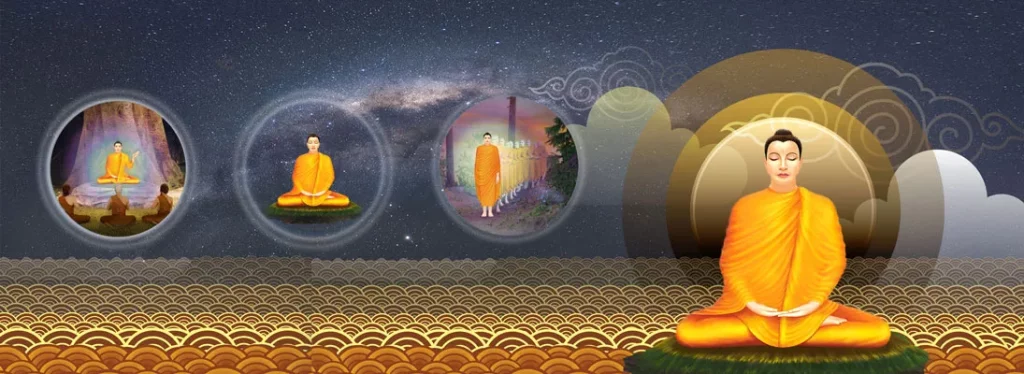
Virtues of the Buddha
The greatest of the Buddha has been admired for a long time for his utmost virtues which are insight, purity and compassion.
Insight: The Buddha possessed the greatest wisdom on the reality of all things and he had an ingenious way of teaching his enlightened wisdom to others depending on each person’s unique character.
Purity: The Buddha possessed the bright and pure mind; it was completely devoid of defilements. He was always peaceful with the pure mind under all circumstances.
Compassion: The Buddha had infinite compassion to all living beings. He taught people to value the life of every living being. He taught people to be kind to each other, so that people can live together in peace and harmony.
The Buddha’s Teachings can be grouped into three main components as follows:
- Abstain from unwholesome deeds
- Perform wholesome deeds
- Keep the mind clean and bright
The Lord Buddha’s enlightened wisdom could not be gained by thinking or imagining but could rather be gained by meditation practice. His teaching is Truth that stands the test of time and space. Whoever practices meditation earnestly and correctly will be able to attain Enlightenment in the same way that He enlightened.
The Lord Buddha’s Teachings and his daily virtuous activities have shown that he is the “Greatest Teacher” who has truly and enormously benefited humanity.
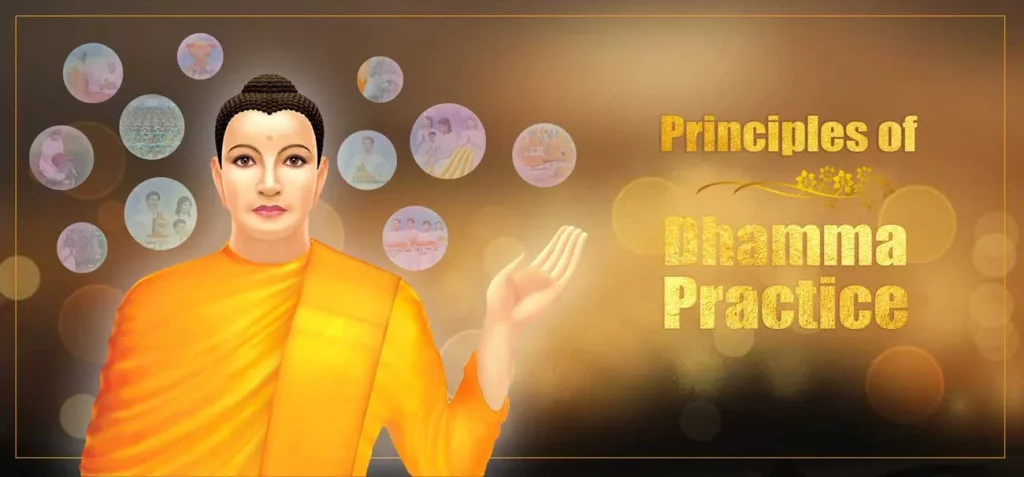
Principles of Dhamma Practice
On Visakha Puja Day, Buddhists around the world adhere in Buddhism’s Principles and the Dhamma Practices which we should do as follows ;
1.Gratitude
Gratitude is the principle that Buddhists should cultivate in their mind on the day of Vesak to recollect the birth of the Lord Buddha, who was born for the benefit of the humanity and the world.
Gratitude is a deeper appreciation for those who have done something for us. Acts of gratitude show how thankful we are for what we have received. One who initially does something for another is, in Pali, called pubbakari “the firstdoer” or “previous benefactor” which includes, for example, parents and teachers.
In Buddhism, the Lord Buddha is the pubbakari, “the firstdoer.” As he founded the Buddhist religion and showed the way to the end of suffering to those worthy of instruction. To show our gratitude, we make two kinds of offering: material and spiritual. The followers of the Lord Buddha show their gratitude towards the Master by organizing the day of Vesak celebrations to promote Buddhism and by practicing the Dhamma so that Buddhism will remain for many years to come.
2.The Four Noble Truths
The Four Noble Truths are the principles that the Buddhists should bear in mind on the day of Vesak because it is the day upon which the Lord Buddha realized those truths. The Four Noble Truths constitute the highest truth. Therefore, they do not change and they are true for every one of us. They are suffering, the cause of suffering, the cessation of suffering and the way to the cessation of suffering.
- Suffering : The Lord Buddha taught that suffering is intrinsic; it occurs in daily life and is common to all human beings. Intrinsic suffering includes the suffering of birth, old age and death. On a daily basis, it includes separation from loved ones, association with what one does not like and not having what one wants.
- The cause of suffering : It is the root of the problem. The Lord Buddha said that all suffering has its cause and that cause is tanha (lust), desire and grasping.
- The cessation of suffering: The problem of suffering can be resolved. According to the Lord Buddha, all kinds of suffering can be eliminated by the elimination of tanha, that is, the eradication of desire.
- The way to the cessation of suffering : It is the means of resolving the problem. The Lord Buddha taught that the solution to all life’s problems is the cessation of suffering, which can be achieved by following the Noble Eightfold Path which consists of eight practices: right view, right thought, right speech, right action, right livelihood, right effort, right mindfulness, and right Samadhi (meditative absorption or union) with its threefold training in morality, concentration and wisdom.
3.Mindfulness
Mindfulness means to always review the positive and negative aspects of oneself before doing, speaking or thinking. Mindfulness is the state of mind in which one knows at the present moment what one is doing. Mindfulness can be practiced in all postures through constant attentiveness while standing, walking, sitting and lying down, and also when speaking, thinking or undertaking any other activities.
Mindfulness is part of the Dhamma that Buddhists should bear in mind on the day of Vesak before he passed away, the Lord Buddha gave his final instruction which was “Subject to decay are all component things, work out your salvation with diligence.”
Therefore, mindfulness is an important principle. All of the Lord Buddha’s teachings can be summarized under this mindfulness.

Visakha Puja Day (Vesak) and the United Nations
On 13 December 2542 B.E.(1999), the General Assembly of the United Nations officially recognized Visakha Puja Day, or Vesak Day as traditionally known by Sri Lankans, as an International Day of the World. Sri Lanka was a key member of the original group of co-sponsors for a resolution requesting the United Nations to recognize Vesak as a special day. The goal is to make Vesak internationally known as the day Buddhists throughout the world assembled to perform meritorious deeds and to commemorate the Buddha’s Birth, Enlightenment, and Attainment of Complete Nirvana. It is also to acknowledge the Buddha as a benevolent human being endowed with great wisdom and immense compassion and goodwill for all living beings. The Buddha encouraged all religious groups to examine his teaching and to verify the truth for themselves, without the need to abandon their own faith. He taught and shared His great wisdom to all living beings without seeking anything in return.
A Message from the former Secretary-General of the United Nations, Javier Perez de Cuellar, to Buddhists on the Day of Vesak in May 1986 was;
“For Buddhists everywhere it is indeed a felicitous opportunity, while commemorating the birth, enlightenment and passing away of Guatama Buddha, to celebrate his message of compassion and devotion to the service of humanity. This message is today perhaps more relevant than ever before.”
Message of the current United Nations Secretary-General Mr.António Guterres
I send warm wishes to all celebrating the Day of Vesak, a sacred occasion to millions of Buddhists around the world. As we honor the birth, enlightenment and passing of Lord Buddha, we can all be inspired by his teachings. And as the human family suffers the impacts of the COVID-19 pandemic, we are reminded of the sutra: “Because all living beings are subject to illness, I am ill as well.” This timeless message of unity and service to others is more important than ever. It is only together that we will stop the spread of the coronavirus and recover. On the day of Vesak, let us celebrate Lord Buddha’s wisdom by taking action for others with compassion and solidarity, and by renewing our commitment to build a peaceful world.

Visakha Puja Day and World Peace
In commemorating and recollecting the Lord Buddha’s highness loving kindness in which he has compassionately taught people on the reality of life-cycle, Buddhists daily practice his valuable teachings as the way they inherit the Dhamma Principles from the Lord Buddha until nowadays.
On this auspicious day of Visakha Puja, all Buddhists around the world have come together to create world peace by doing good deeds according to his teaching; purify the mind by practicing meditation.
While everyone is meditating until the mind comes to standstill, they themselves will touch upon the true happiness within, it is the happiness which is not required from endlessly seeking outside. And, If we who come from various countries, various cities around the world, and meditate together until we reach inner peace, then the power of our collective pure energy and the true happiness originated from the center of the body will rise and be spread to other people around us. At that time, it could be said that we will become like a happiness magnet which good things and good people will be drawn to us. This means that we are ready to change our surroundings such as families, companies, schools, work-places, societies until the whole countries and the entire world achieve the real true peace within.

